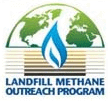Tennessee LMOP Partners
 Tennessee
Department of Environment & Conservation
Tennessee
Department of Environment & Conservation
 Metropolitan
Government of Nashville
Metropolitan
Government of Nashville
 City
of Chattanooga
City
of Chattanooga
 Waste
Management
Waste
Management
 Tennessee
Valley Authority
Tennessee
Valley Authority
 Southern
Alliance for Clean Energy
Southern
Alliance for Clean Energy
 ECE
Services
ECE
Services
 Pioneer
Air Systems, Inc.
Pioneer
Air Systems, Inc.
 Pioneer
Engineering, Inc.
Pioneer
Engineering, Inc.
 Gases
that have always been considered a form of air pollution
are now being looked at as a source of energy. Landfill
gases (LFG) are a natural product of the decomposition/
putrefaction of organic materials in landfills. Modern
design and operation of landfills creates an anaerobic
environment, which leads to the production of many gases,
mostly methane and CO2. Landfills are the largest source
of anthropogenic methane emissions in the United States,
contributing almost 40% of emissions each year, as well
as being a significant source of VOCs and other air
pollutants. Traditionally, captured LFG has usually
been "flared off" at the landfill without
capturing its energy.
Gases
that have always been considered a form of air pollution
are now being looked at as a source of energy. Landfill
gases (LFG) are a natural product of the decomposition/
putrefaction of organic materials in landfills. Modern
design and operation of landfills creates an anaerobic
environment, which leads to the production of many gases,
mostly methane and CO2. Landfills are the largest source
of anthropogenic methane emissions in the United States,
contributing almost 40% of emissions each year, as well
as being a significant source of VOCs and other air
pollutants. Traditionally, captured LFG has usually
been "flared off" at the landfill without
capturing its energy.
The Resource Conservation and Recovery Act, Subtitle D regulates LFG only to the extent that it protects the integrity of the impermeable final cap, prevents buildups that might cause catastrophic explosions, and limits nuisance odors. Therefore capture and controlled release of the LFG has been required by RCRA all along, but it has not addressed other environmental concerns.
Beginning in 1991, Title V of the Clean Air Act designated all landfills with a permitted capacity of 110,000 tons or more as stationary sources of air pollution. This law mandates the monitoring, venting and/or collection and destruction of LFG for new reasons, i.e. to prevent the release of VOCs, toxic, and potentially hazardous compounds. Furthermore, LFG contains "greenhouse gases," which we have obligations to control under the Kyoto Climate Agreement.
The Landfill Methane Outreach Program (LMOP) was established by the Environmental Protection Agency to encourage the capture of LFG for beneficial end-use instead of flaring it off. Tax incentives and technical assistance with project development are offered as a means of encouraging commercial exploitation of LFG, such as generating heat, steam, or electricity. Some landfills use LFG to evaporate leachate. As many as 343 U.S. landfills are economically converting methane into a marketable energy source, according to the EPA. EPA's LMOP works with state agency allies to make landfill operators aware of all their compliance options and the economic potential of energy recovery.
LFG can be captured while a landfill is still active and for a certain period after it has been closed. Its generation rates are predictable based on the design and amount of waste disposed in a landfill. Now, some landfills are being purposefully designed and operated to maximize LFG generation. These methods vary somewhat from traditional ones because the landfill is being operated as a moist bioreactor vessel instead of a dry tomb.
The economic motives for landfill operators are: federal tax credits; income from energy production; less financial assurance due to shorter post-closure period (because decomposition and settling run their course more quickly;) achieving early compliance with new clean air regulations; and improving economic development near landfills.
The environmental benefits are: reducing the release of significant amounts of air pollution that contribute to smog, odors, and global warming; pollution prevention by replacing combustion of fossil fuels with a cleaner renewable energy source; and germination of "green" industrial parks where industries use each others' waste as fuel or feedstock.
LMOP is a voluntary public/ private outreach program. Its mission is to create alliances between states, energy users, communities, and the LFG-to-energy industry in order to lower barriers to and promote the development of cost-effective LFGTE projects. LMOP has four ally/partner programs: Energy Ally (utilities,) Industry Ally (technology vendors/ consultants,) State Ally (government,) and LMOP Partner (users.) These agreements are voluntary and non-binding.
A preliminary study by the EPA indicates that there are at least 25 landfills in Tennessee that could produce in excess of 75 megawatts of electricity. This is enough power to meet the demand of 53,611 homes here. If the electricity produced replaces fossil fuel, the total greenhouse gas reductions would be the equivalent of removing 1,260,128 automobiles from Tennessee's roads or planting 851,541 acres of trees, according to the EPA. In Tennessee, three landfills, Bordeaux in Nashville, Chestnut Ridge near Knoxville, and Quail Hollow near Shelbyville, are recovering LFG for beneficial end use.
The Tennessee Department of Environment & Conservation, Division of Community Assistance has signed a memorandum of understanding with the EPA, making the department a State Ally. Under this agreement, DCA promotes the LMOP as part of a nationwide strategy to stabilize greenhouse gas emissions and to meet our state's environmental, energy, and economic objectives. DCA also works with the EPA and other partners in the state to review and explore opportunities to overcome any unnecessary regulatory, administrative, or other barriers to development of landfill gas-to-energy projects in Tennessee. DCA works with the EPA to develop and distribute state-specific outreach materials such as the Tennessee LFG Primer. The EPA provides support for implementing these activities and provides public recognition to government and business allies.
For more information on Tennessee's Landfill Methane Gas Outreach Program, please contact Louis Bordenave 615-532-0095 or by email at [email protected].



